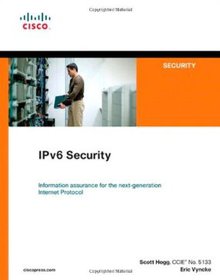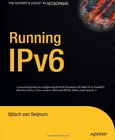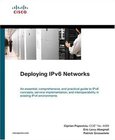IPv6 Security

Book Details:
| Publisher: | Cisco Press |
| Series: | Cisco Press |
| Author: | Scott Hogg |
| Edition: | 1 |
| ISBN-10: | 1587055945 |
| ISBN-13: | 9781587055942 |
| Pages: | 576 |
| Published: | Dec 21 2008 |
| Posted: | Nov 19 2014 |
| Language: | English |
| Book format: | |
| Book size: | 5.52 MB |
Book Description:
IPv6 Security Protection measures for the next Internet Protocol As the world's networks migrate to the IPv6 protocol, networking professionals need a clearer understanding of the security risks, threats, and challenges this transition presents. In IPv6 Security, two of the world's leading Internet security practitioners review each potential security issue introduced by IPv6 networking and present today's best solutions. IPv6 Security offers guidance for avoiding security problems prior to widespread IPv6 deployment. The book covers every component of today's networks, identifying specific security deficiencies that occur within IPv6 environments and demonstrating how to combat them. The authors describe best practices for identifying and resolving weaknesses as you maintain a dual stack network. Then they describe the security mechanisms you need to implement as you migrate to an IPv6-only network. The authors survey the techniques hackers might use to try to breach your network, such as IPv6 network reconnaissance, address spoofing, traffic interception, denial of service, and tunnel injection. The authors also turn to Cisco products and protection mechanisms. You learn how to use Cisco IOS and ASA firewalls and ACLs to selectively filter IPv6 traffic. You also learn about securing hosts with Cisco Security Agent 6.0 and about securing a network with IOS routers and switches. Multiple examples are explained for Windows, Linux, FreeBSD, and Solaris hosts. The authors offer detailed examples that are consistent with today's best practices and easy to adapt to virtually any IPv6 environment. Scott Hogg, CCIE No. 5133, is Director of Advanced Technology Services at Global Technology Resources, Inc. (GTRI). He is responsible for setting the company's technical direction and helping it create service offerings for emerging technologies such as IPv6. He is the Chair of the Rocky Mountain IPv6 Task Force. Eric Vyncke, Cisco Distinguished System Engineer, consults on security issues throughout Europe. He has 20 years' experience in security and teaches security seminars as a guest professor at universities throughout Belgium. He also participates in the Internet Engineering Task Force (IETF) and has helped several organizations deploy IPv6 securely. Understand why IPv6 is already a latent threat in your IPv4-only network Plan ahead to avoid IPv6 security problems before widespread deployment Identify known areas of weakness in IPv6 security and the current state of attack tools and hacker skills Understand each high-level approach to securing IPv6 and learn when to use each Protect service provider networks, perimeters, LANs, and host/server connections Harden IPv6 network devices against attack Utilize IPsec in IPv6 environments Secure mobile IPv6 networks Secure transition mechanisms in use during the migration from IPv4 to IPv6 Monitor IPv6 security Understand the security implications of the IPv6 protocol, including issues related to ICMPv6 and the IPv6 header structure Protect your network against large-scale threats by using perimeter filtering techniques and service providerfocused security practices Understand the vulnerabilities that exist on IPv6 access networks and learn solutions for mitigating each This security book is part of the Cisco Press Networking Technology Series. Security titles from Cisco Press help networking professionals secure critical data and resources, prevent and mitigate network attacks, and build end-to-end self-defending networks. Category: Networking: Security Covers: IPv6 Security
Download Link:
Related Books:
IPv6 Fundamentals
A Straightforward Approach to Understanding IPv6
To support future business continuity, growth, and innovation, organizations must transition to IPv6, the next generation protocol for defining how computers communicate over networks. IPv6 Fundamentals provides a thorough yet easy-to-understand introduction to the new knowledge and skills network professionals and students need to deploy and manage IPv6 networks. Leading networking instructor Rick Graziani explains all the basics simply and clearly, one step at a time, providing all the details you'll need to succeed. Building on this introductory coverage, he then introduces more powerful techniques that involve multiple protocols and processes and provides hands-on resources you can rely on for years to come. You'll begin by learning why IPv6 i...
Running IPv6
Running IPv6 explains how to install and operate the IPv6 protocol for Windows XP, Mac OS X, FreeBSD, Red Hat Linux, and Cisco routers. The book also covers DNS and BIND, Zebra, Apache 2, and Sendmail. While IPv4 uses 32-bit addresses, IPv6 addresses are 128 bits long, and allow for more unique addresses. While the adoption of IPv6 wont be immediate, it is necessary. Running IPv6 compares and contrasts IPv6 to IPv4, and discusses the advantages and disadvantages of each. Because most major software and hardware vendors have adopted IPv6, the focus of this book is to leverage your existing knowledge of IPv4 and to help you apply that knowledge to the newer protocol. Table of Contents IPv6 Getting Started Tunnels Routing The DNS Applications The ...
Deploying IPv6 Networks
An essential, comprehensive, and practical guide to IPv6 concepts, service implementation, and interoperability in existing IPv4 environments After completing Deploying IPv6 Networks, you will: Understand the current state of IPv6 technologies and services Understand the IPv6 features as they are applied in service deployments Be prepared with guidelines on how to ready your organization for a migration to IPv6 Know how to design and implement an IPv6 production-level network using the book's templates and examples Have the ability to configure and troubleshoot IPv6 networks Know where IPv6 developments are moving in the future Large IPv6 production deployments worldwide are proof that the transition to the next generation of the IP protocol is no...
2007 - 2021 © eBooks-IT.org



